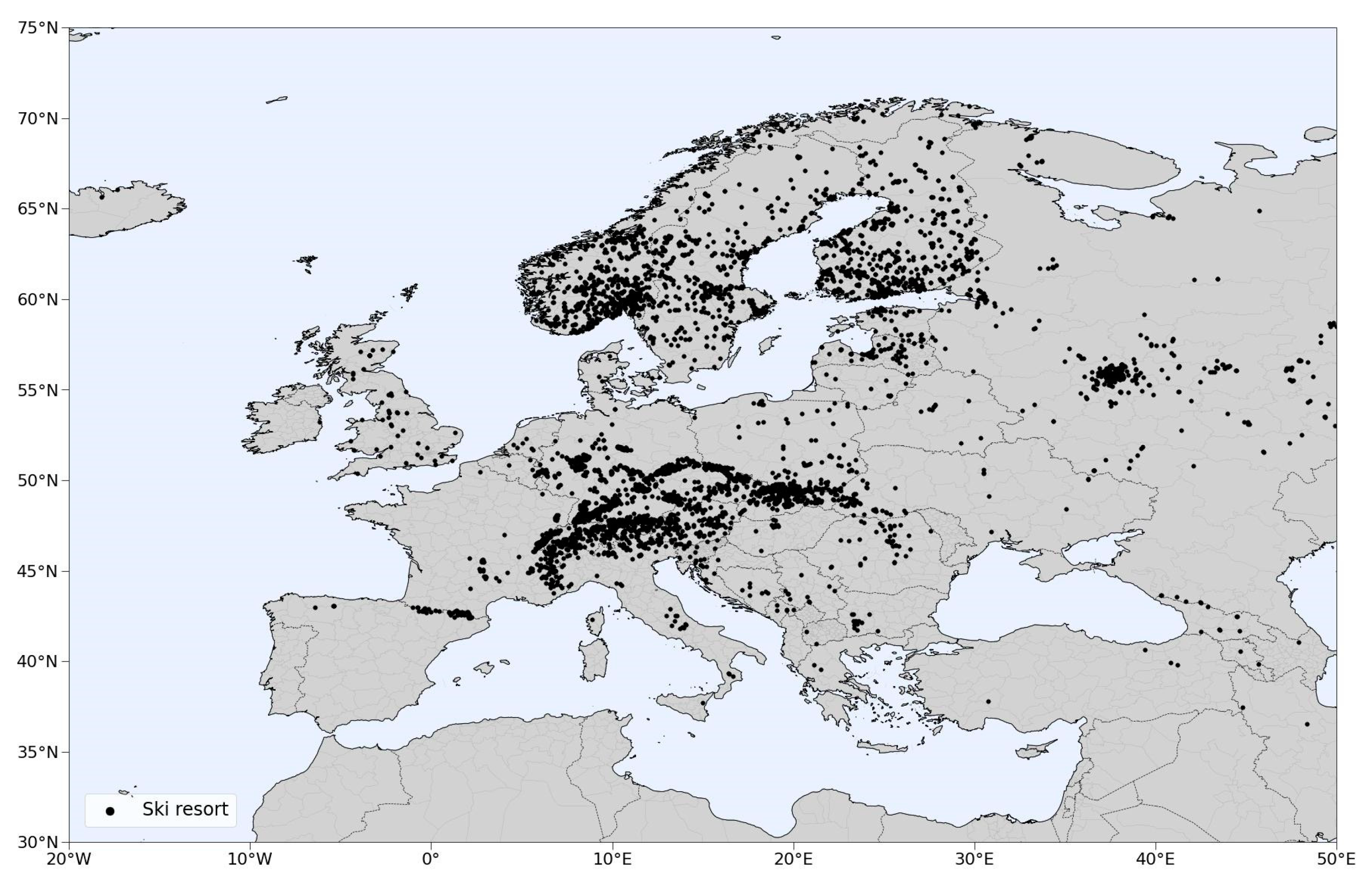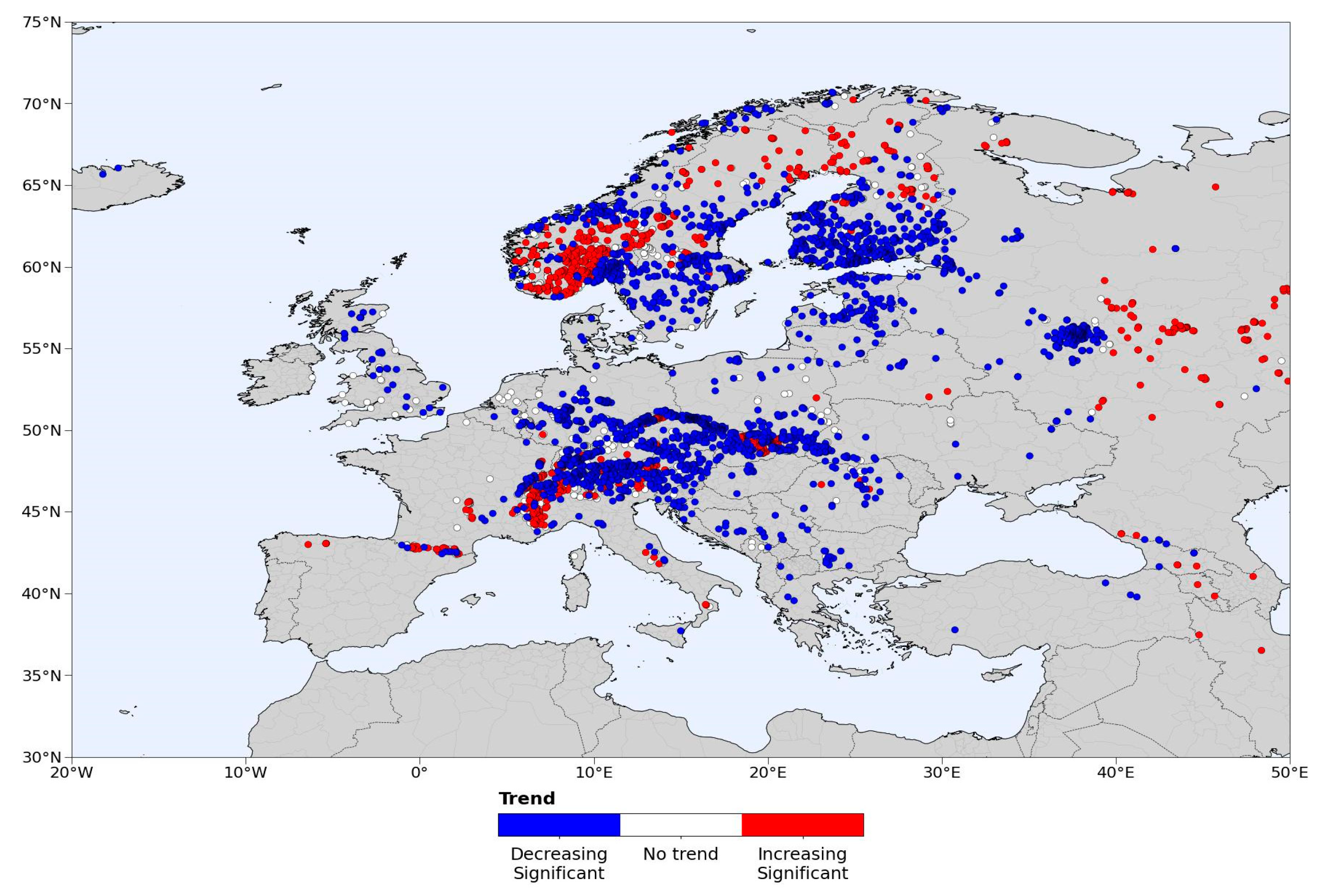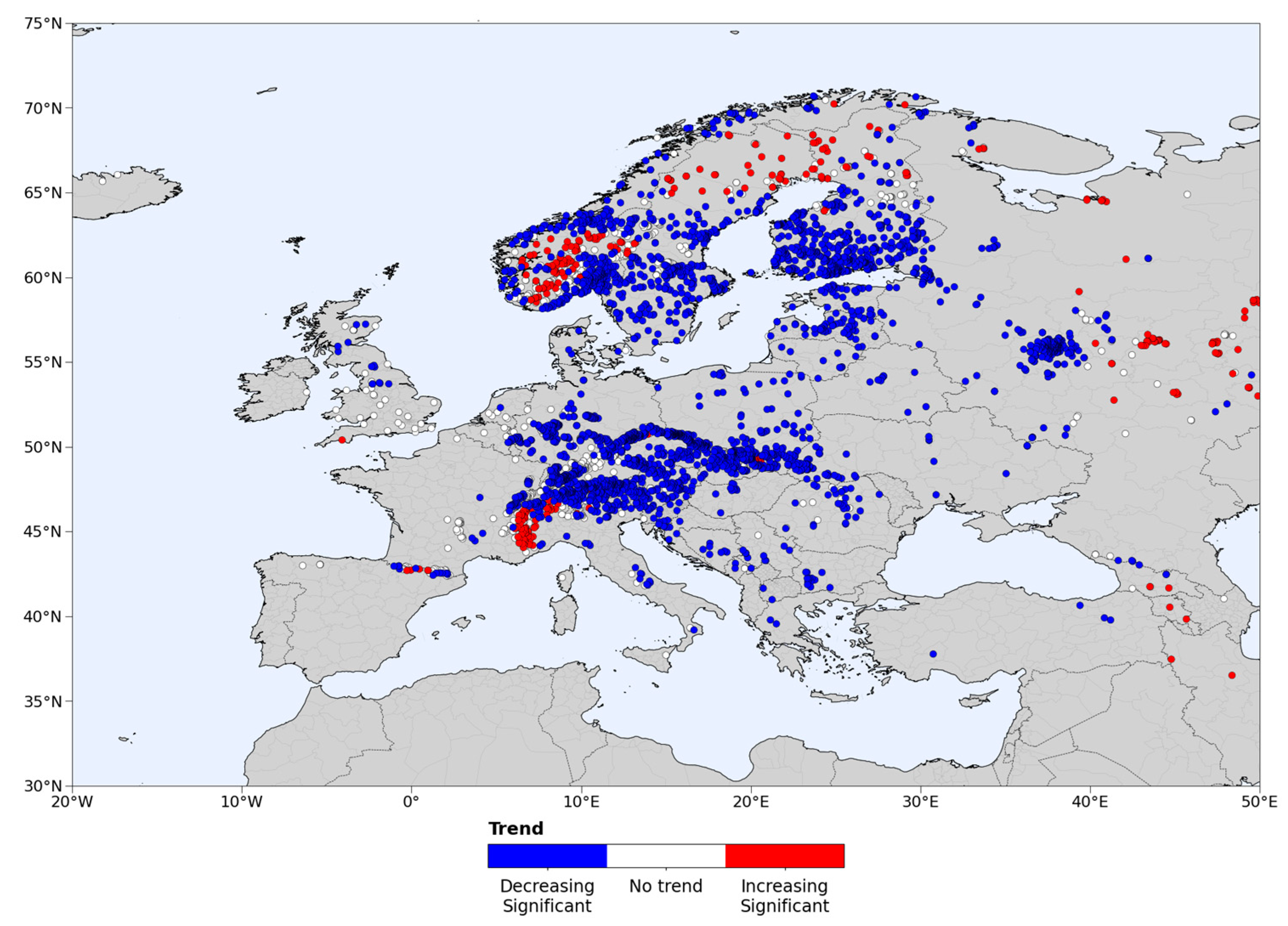1. Introduction
Winter tourism is a major socio-economic sector in Europe, especially in the mountainous regions where ski resorts depend on the weather conditions for natural snow or snowmaking. Based on 2017 global market numbers, it is estimated that about 350 million people visit the ski resorts per year. Many studies have warned, in the past several decades, that ski tourism in Europe is under a major threat due to climate change because of increasing air temperature and natural snow scarcity at low elevation [
1].
A significant shortening of the ski season is projected as early as the 2030s, which will have a direct implication on winter industry employment and on real estate values of vacation properties [
2]. For example, a study for Slovakia projected that a 1 °C temperature increase would lead to a 6% loss of lift ticket sales, with much larger losses (19%) under a high-emission scenario (+3.2 °C) [
3].
The IPCC’s Sixth Assessment Report identified major gaps in the ski tourism literature for Europe (especially Eastern Europe), as it is underrepresented in climatological studies related to snow [
4]. The latest pan-European study for climate change impact on ski tourism was published in 2021, and it serves as a part of the “European Tourism” Sectoral Information System (SIS) of the Copernicus Climate Change Services (C3S) [
1]. The results of this study partly based on reanalysis data between 1960 and 2015 showed a great inter-annual variability in snow conditions, but also an important decrease in snow depth in European mountains for the 21st century, regardless of the climate scenario.
In the current study, we attempt to investigate trends in natural snow depth in a pan-European domain using a reanalysis model, and discuss comparisons across European regions and results from previous studies using different datasets.
2. Data and Methods
2.1. Data
The Copernicus European Regional Re-Analysis Land (CERRA-Land) dataset was used to study the maximum daily snow depth between 1985 and 2020, in 5595 ski resorts in Europe, registered in
https://skimap.org/ (accessed on 25 January 2023). CERRA-Land is a regional land surface reanalysis dataset provided by the Copernicus Climate Change Service at a spatial resolution of 5.5 km [
5]. CERRA-Land snow depth has been evaluated in the Alps, where it was proven to provide a satisfying description of the monthly snow evolution [
6].
The maximum and minimum elevation of each ski resort was available in the metadata of Skimap.org, and their average elevation was first compared with the nearest grid point elevation in CERRA-Land. The ski resorts that had an average elevation difference larger than 150 m in absolute value from the elevation of the corresponding CERRA-Land grid point were discarded from the analysis. This threshold was chosen based on the standard deviation of elevation difference between the model and real values. In total, 4507 ski resorts were used in the computations (
Figure 1).
Regarding the elevation of ski resorts, 88 of them are situated more than 2000 m above mean sea-level mainly in the Alps, 188 have an average elevation between 1500 and 2000 m, 441 have an elevation between 1000 and 1500 m, and 3790 have an average elevation below 1000 m mostly situated in Scandinavia, the Baltic States, United Kingdom, Russia, and Central Europe.
2.2. Methods
Trend analysis of snow depth was performed on daily snow depth values. A non-parametric Mann–Kendall test was applied to the time series [
7] in order to detect any significant trend (at 5% level) over the examined period between 1985 and 2020. The advantage of this non-parametric test over other parametric tests is that it is more suitable for non-normally distributed data (i.e., missing or extreme values) frequently encountered in snow depth time series.
3. Results
Statistically significant decreasing trends for snow depth were found for all the seasons, with spring having the greatest decrease in natural snow depth according to CERRA-Land. More specifically, 79.5% of ski resorts have a statistically significant decreasing trend of snow depth in autumn and mostly those in low mountains, with elevation below 1000 m.
In winter, 63% of ski resorts exhibit a statistically significant decreasing trend, and most of them are found in the Alps, Central Europe, and Scandinavia (
Figure 2). In the Alps, results are mixed for winter months, with a statistically significant increasing trend of snow depth found for ski resorts above 2000 m. Similar increase in snow depth in winter was found in the highest resorts of South Norway (>500 m).
In spring, 91% of ski resorts in Europe show a significant decreasing trend in snow depth (
Figure 3) and only 3.3% have an increasing trend, situated in Northern Scandinavia and Russia. In contrast to winter, in spring, statistically decreasing trends dominate all elevations.
In summer, only 200 ski resorts receive snow according to CERRA-Land, and the majority of them (159) have experienced a statistically significant decreasing trend since 1985.
Specific computations were performed for the economically critical period for ski resorts, around Christmas. The trends in snow depth were calculated between 20 December and 5 January and showed that 72.7% of all ski resorts experienced a significant reduction in natural snowpack. In the Western Alps, Pyrenees, and South Norway though, an increasing trend of snow depth is evident (
Figure 4).
4. Discussion and Conclusions
Previous studies dedicated to snow climatology have addressed decreasing trends in snow depth in many European regions that have an important winter tourism industry [
1,
2,
6,
8]. Our study based on CERRA-Land reanalysis data confirms these results and provides some new insights on spatial variability of snow depth in ski resorts in Europe. The main difference with previous studies is that we investigate snow depth trends at specific ski resorts, rather than in administrative regions [
1] or a mountain range [
8].
Results show that the majority of European ski resorts experience a decreasing trend in snow depth for every season, especially in spring. More specifically at a regional scale, the Alps have seen a significant reduction in snow depth in winter and in spring, but mostly at elevations below 2000 m. Ski resorts at higher elevations have an increasing trend, but further investigation is needed to examine the role of temperature and precipitation trends, as well as the duration of the snow cover period. Previous studies for the Alps have shown a reduction in winter precipitation, and a significant decrease in the snowpack, with a 10% decline in the winter snow depth and about -10 days with snow cover per decade, especially at low and intermediate elevations [
6,
8].
Mixed results for snow depth trends can be also found in Scandinavia, with a dominant decreasing trend in winter in the low-elevation ski resorts in southern parts of Sweden and Finland (
Figure 2), but some increasing trends are found in the high-elevation ski resorts in South Norway. Nevertheless, previous studies have shown a considerable imminent shortening of the ski season and reduction in winter snowpack in Norway and Sweden in the near future [
9,
10].
The ski tourism industry in Europe has been under stress in the past decades due to a considerable decrease in natural snow. Due to the unfavorable conditions for natural snow in ski resorts, new operational practices have been used for artificial snowmaking, but these applications are also influenced by the local meteorological conditions. Moreover, not all ski resorts have the capacity and natural resources (i.e., water reservoirs) to afford the increasing snowmaking demand.
Author Contributions
Conceptualization, data curation, formal analysis, investigation, methodology, software, validation, visualization, writing—original draft, I.M.; Conceptualization, project administration, resources, supervision, writing—review and editing, S.D.; Data curation, supervision, software, visualization, G.K.; Project administration, resources, supervision, K.L. All authors have read and agreed to the published version of the manuscript.
Funding
This research received no external funding.
Institutional Review Board Statement
Not applicable.
Informed Consent Statement
Not applicable.
Data Availability Statement
Conflicts of Interest
The authors declare no conflict of interest.
References
- Morin, S.; Samacoïts, R.; François, H.; Carmagnola, C.M.; Abegg, B.; Demiroglu, O.C.; Pons, M.; Soubeyroux, J.M.; Lafaysse, M.; Franklin, S.; et al. Pan-European meteorological and snow indicators of climate change impact on ski tourism. Clim. Serv. 2021, 22, 100215. [Google Scholar] [CrossRef] [PubMed]
- Steiger, R.; Scott, D.; Abegg, B.; Pons, M.; Aall, C. A critical review of climate change risk for ski tourism. Curr. Issues Tour. 2019, 22, 1343–1379. [Google Scholar] [CrossRef]
- Demiroglu, O.C.; Kučerová, J.; Ozcelebi, O. Snow reliability and climate elasticity: Case of a Slovak ski resort. Tour. Rev. 2015, 70, 1–12. [Google Scholar] [CrossRef]
- IPCC. Climate Change 2022: Impacts, Adaptation and Vulnerability; Contribution of Working Group II to the Sixth Assessment Report of the Intergovernmental Panel on Climate Change; Pörtner, H.-O., Roberts, D.C., Tignor, M., Poloczanska, E.S., Mintenbeck, K., Alegría, A., Craig, M., Langsdorf, S., Löschke, S., Möller, V., et al., Eds.; Cambridge University Press: Cambridge, UK; New York, NY, USA, 2022; 3056p. [Google Scholar]
- Verrelle, A.; Glinton, M.; Bazile, E.; Le Moigne, P.; Randriamampianina, R.; Ridal, M.; Berggren, L.; Undén, P.; Schimanke, S.; Mladek, R.; et al. CERRA-Land Sub-Daily Regional Reanalysis Data for Europe from 1984 to Present; Copernicus Climate Change Service (C3S) Climate Data Store (CDS): Reading, UK, 2022. [Google Scholar] [CrossRef]
- Monteiro, D.; Morin, S. Multi-decadal past winter temperature, precipitation and snow cover information over the European Alps using multiple datasets. EGUsphere 2023, preprint. [Google Scholar] [CrossRef]
- Sneyers, R. On the Statistical Analysis of Series of Observations; Technical Note No. 143, WMO No. 415; World Meteorological Organization: Geneva, Switzerland, 1990; 192p. [Google Scholar]
- Matiu, M.; Crespi, A.; Bertoldi, G.; Carmagnola, C.M.; Marty, C.; Morin, S.; Schöner, W.; Cat Berro, D.; Chiogna, G.; De Gregorio, L.; et al. Observed snow depth trends in the European Alps: 1971 to 2019. Cryosphere 2021, 15, 1343–1382. [Google Scholar] [CrossRef]
- Scott, D.; Steiger, R.; Dannevig, H.; Aall, C. Climate change and the future of the Norwegian alpine ski industry. Curr. Issues Tour. 2020, 23, 2396–2409. [Google Scholar] [CrossRef]
- Rice, H.; Cohen, S.; Scott, D.; Steiger, R. Climate change risk in the Swedish ski industry. Curr. Issues Tour. 2022, 25, 2805–2820. [Google Scholar] [CrossRef]
| Disclaimer/Publisher’s Note: The statements, opinions and data contained in all publications are solely those of the individual author(s) and contributor(s) and not of MDPI and/or the editor(s). MDPI and/or the editor(s) disclaim responsibility for any injury to people or property resulting from any ideas, methods, instructions or products referred to in the content. |
© 2023 by the authors. Licensee MDPI, Basel, Switzerland. This article is an open access article distributed under the terms and conditions of the Creative Commons Attribution (CC BY) license (https://creativecommons.org/licenses/by/4.0/).












